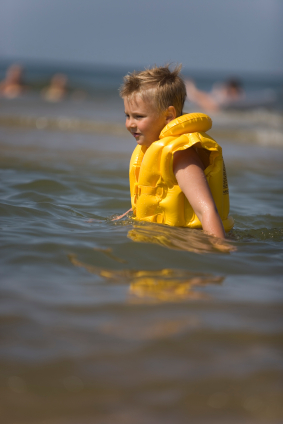The primary function of a personal flotation device (PFD) (what used to be called a life jacket) or life vest) is to keep your child afloat, with his mouth well above water so he can breath. It's critical that the life jacket you pick for child meets this test.
PFDs come in a variety of shapes, sizes, colors, and materials. Some PFDs are made to be more rugged and last longer while others are made to protect a child from cold water. No matter which life jacket you choose, be sure to get one that is right for your child, the planned activities, and the water conditions you expect to encounter.

Selecting a PFD
- Select a properly sized PFD. Check the label for proper weight range to match your child's weight.
- Make sure the PFD is Coast Guard approved.
- Make sure your child tries on the PFD to make sure it fits comfortably snug.
- Insure all straps, zippers, and ties are fastened.
- Raise your child's arms over her head and lift the PFD straight up by the shoulders to make sure the life jacket stays in place. If your child's mouth and nose fall below the topmost edge at the shoulder or collar, or it almost comes off, the PFD is too loose.
Buoyancy Testing
A child's PFD should be tested in the water immediately after purchase. Children panic when they fall into the water suddenly. They move their arms and legs violently and try to climb out of the water, making it hard to float safely in a life jacket. A life jacket will keep a child afloat, but may not keep a struggling child face-up. That is why it is so important to teach children how to put on a life jacket and to teach them to relax in the water.
- Test the PFD on your child in shallow water to see how it floats her.
- Put on the life jacket and insure that all straps, zippers, and ties are fastened.
- Tuck in any loose strap ends.
- Have your child relax his body and let his head tilt back.
- Make sure the PFD keeps his chin above water and that he can breathe easily.
- If his mouth is not well above the water, get a new personal flotation device or one with more buoyancy.
For additional information contact the, National Safe Boating Council at:
Phone 703/361-4294
Fax: 703/361-5294
www.safeboatingcampaign.com
Source: National Safe Boating Council
Posted May 5, 2011








